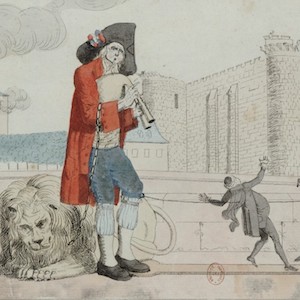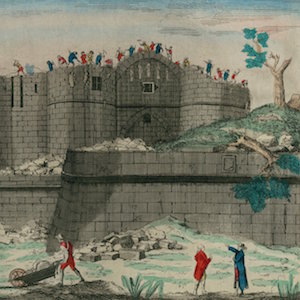Europe

Memorable Day at Versailles, 5 October 1789
This engraving marks success and reconciliation among revolutionaries, as men and women, as well as soldiers and civilians, relax together.

The Day of 21 July 1789
More common than clashes by workers against employers were protests over the rising price of bread. This color drawing depicts events at the City Hall of Strasbourg on 21 July 1789.

Farewell Bastille
This hand–colored engraving equates the taking of the Bastille with the rise of the Third Estate against the clergy and nobility. A commoner in a black hat sporting a tricolor cockade plays the bagpipe triumphantly over the fallen lion of the absolutist monarchy.

Demolition of the Bastille
This watercolor painting illustrates the "demolition" of what the text refers to as the "horrible prison" of the Bastille. As workmen tear down the spires on the roof, ordinary people rip stones off the base.

Punishment of Foulon
This engraving reveals the aftermath of the seizure of the Bastille. Here the crowd parades the severed head of the official, Foulon.

Attack on the Bastille
This engraving of the attack highlights the heroism of the people charging determinedly into the billowing clouds and firing relentlessly in the face of strong resistance emanating from the fortress.

Lady Florentia Sale Diary
Lady Florentia Sale (1790-1853), wife of Major-General Sir Robert Henry Sale, wrote a journal of her experiences during the First Afghan War.

Sati Engraving, Burning a Hindoo Widow
Toward the end of the 1700s, the evangelical movement in Britain argued that one’s commitment to Christ should be reflected in action, primarily the effort to end slavery in the British empire and to proselytize or seek converts among the “heathen.” Initially, the English East India Company had p

The True Woman
This is a 17th-century French engraving entitled The True Woman.

Woman with Lenin/Stalin Flag
Articles and images published in Soviet newspapers on March 8, International Communist Woman’s Day, provide the most obvious examples of how women were used as symbols in a propaganda campaign.